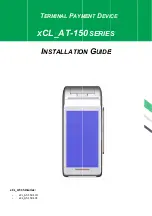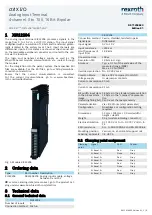
Selesta Ingegneria S.p.A.
RFIDat
‐
RFIDock/M
‐
RFIDock/S
‐
RFIDock/L
‐
RFIDock/SA
‐
USB/AL
are products made in Italy by
.
Selesta Ingegneria S.p.A. – Via di Francia 28 – 16149 Genoa – Italy
Tel: +39.010.60291 – Fax: +39.010.6454548 – www.seling.it – www.rfidat.it
SELESTA INGEGNERIA S.p.A.
&
INSTRUCTION MANUAL
The
RFIDat
e
RFIDock
products are distribuited by:
Instruction Manual – Ver. 1.4
‐
16/10/2009
Instruction Manual – Ver. 1.4
‐
16/10/2009 – pag. 12 of 12
FCC ID: XKC
‐
RFIDAT, XKC
‐
RFIDOCK
For transmitters under FCC Part 15 Subpart C, class A or B classification is not applicable. The
transmitter radiated emissions must meet the general limits of Part 15.209, and transmitter AC
line
‐
conducted emissions must meet the requirements of Part 15.207. Both limits are identical
to the class B limits, but there is no provision for meeting a more relaxed limit like class A as
would be allowed under Part 15 Subpart B for unintentional radiators.
This device complies with part 15 of the FCC Rules. Operation is subject to the following two
conditions: (1) This device may not cause harmful interference, and (2) this device must accept
any interference received, including interference that may cause undesired operation.
NOTE: This equipment has been tested and found to comply with the limits for a Class B digital
device, pursuant to part 15 of the FCC Rules. These limits are designed to provide reasonable
protection against harmful interference in a residential installation. This equipment generates,
uses and can radiate radio frequency energy and, if not installed and used in accordance with the
instructions, may cause harmful interference to radio communications. However, there is no
guarantee that interference will not occur in a particular installation. If this equipment does
cause harmful interference to radio or television reception, which can be determined by turning
the equipment off and on, the user is encouraged to try to correct the interference by one or
more of the following measures:
— Reorient or relocate the receiving antenna.
— Increase the separation between the equipment and receiver.
— Connect the equipment into an outlet on a circuit different from that to which the receiver
is connected.
— Consult the dealer or an experienced radio/TV technician
for help.
























